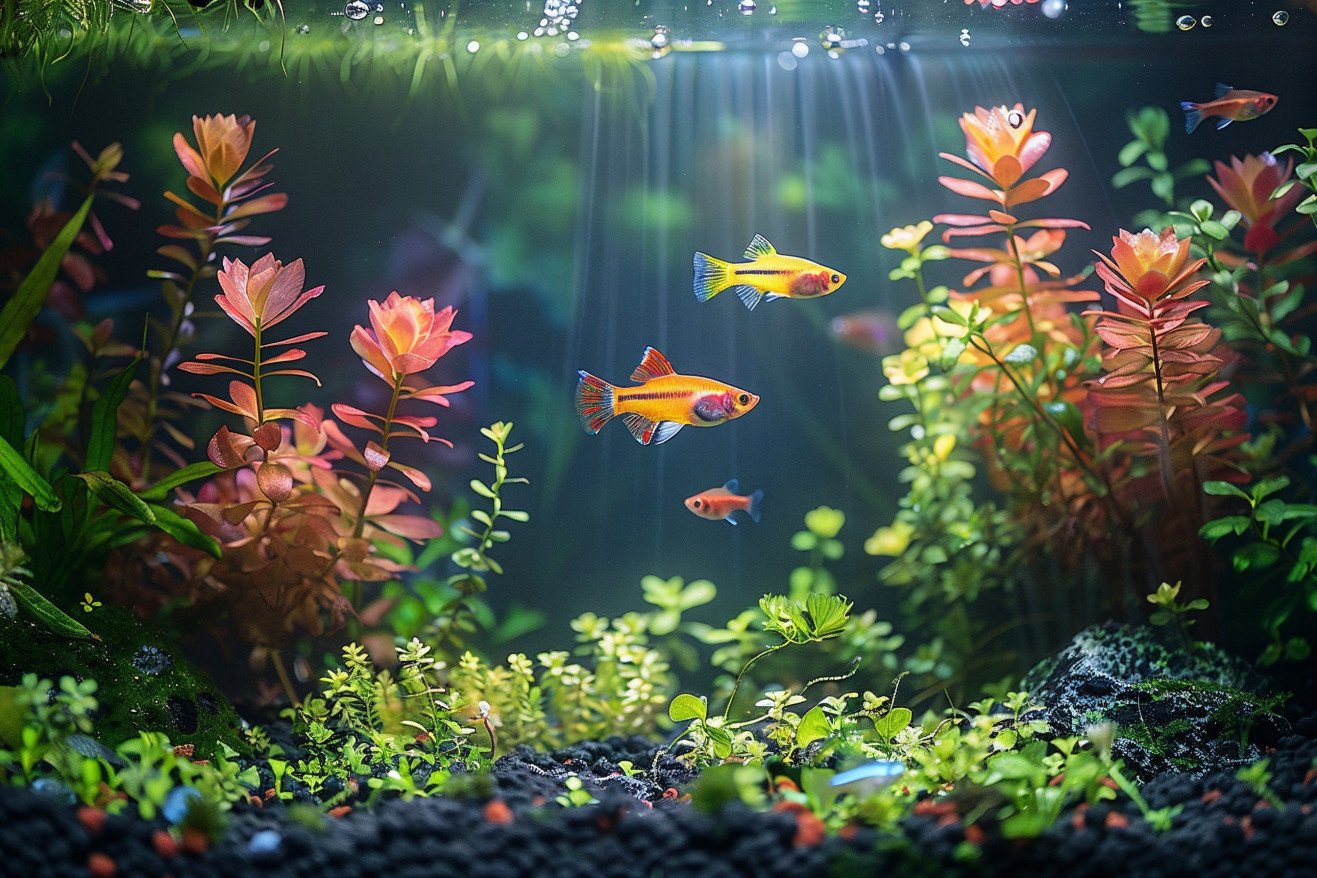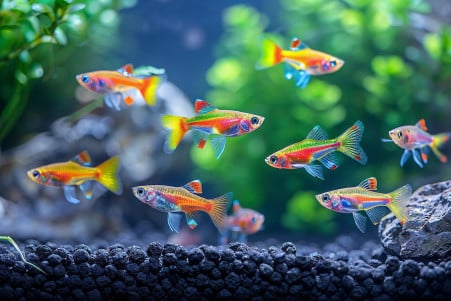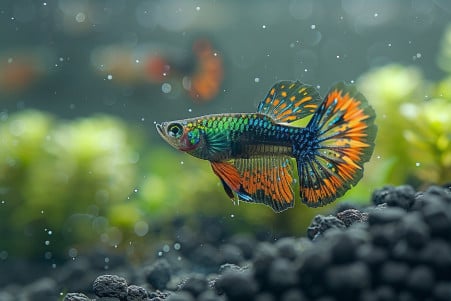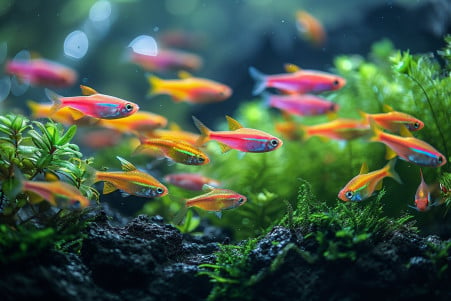How Many Guppies Can You Have in a 5-Gallon Tank? Ideal Guppy Count
9 March 2024 • Updated 9 March 2024

The first step to optimizing your 5-gallon tank’s ecosystem is to understand how many guppies you can have in your tank. In a 5-gallon tank, you can have one male and one female guppy or up to four male guppies. It’s important to make sure that you don’t have more than the recommended number to make sure that your guppies are happy and healthy, as overcrowding can lead to stress and poor water quality.
In addition to the above, we will also go deeper into the research that informs these recommendations. We will explore ichthyology, aquarium husbandry, and animal welfare science research to break down the factors of tank size, fish behavior, and environmental requirements that impact the well-being of guppies.
This knowledge will help you better understand how to set up a successful environment for your guppies, ensuring that they are happy and healthy in a 5-gallon tank.
How many guppies can you have in a 5-gallon tank?
Stocking Density and Guppy Social Behavior
Stocking density is a critical concept in aquarium keeping that determines the amount of living space each fish has in a tank. It is important for the welfare of the fish and has implications for health and behavior.
Guppies are social animals that live in groups and exhibit schooling behavior and complex social interactions. As a result, guppies need enough space to not only be physically comfortable but also to engage in their natural social behaviors.
Unfortunately, the commonly used ‘one inch per gallon’ rule doesn’t take this into account and doesn’t consider swimming behavior and social needs, making it impractical and unhelpful, especially for guppies. This is further supported by a critique in Aquarium Science, which also notes that other factors, such as fish volume and metabolic weight, should be considered when determining stocking density.
Overcrowding can have a number of negative effects on guppy welfare, including stress, aggression, and the spread of disease. This is supported by the scientific literature, including research on zebrafish, a model organism that shares many characteristics with guppies, that has shown that higher stocking densities can affect reproductive performance and stress responses.
That said, with the right filtration and tank maintenance, higher stocking densities can sometimes be accommodated by experienced aquarists, as noted by Aquarium Science.
Aquarists need to work to maintain a carefully balanced environment to keep guppies healthy and happy. As we’ve discussed water quality parameters, it’s important to remember that the balance between stocking density and water quality is critical to the success of guppies in the aquarium.
Water Conditions for Guppies
Having the right water conditions is essential for guppy health. The ideal water temperature for guppies is between 74℉ and 82℉, according to the Micro Aquatic Shop. Guppies can tolerate a wide range of temperatures, but it’s important to keep the water temperature stable. If the water temperature fluctuates too much outside of their preferred range, guppies can become stressed, which can make them more susceptible to health problems like fin rot or hypothermia.
In terms of pH levels, guppies prefer slightly alkaline water with a pH between 6.8 and 7.8. This pH range is ideal for their biological functions and is similar to the pH of many municipal water supplies. It’s important to keep the water conditions stable because guppies are so resilient, they can be shocked by sudden changes in their environment, which can have fatal results.
In addition to their personal health, guppies can help control mosquito populations by eating larvae and reducing the spread of mosquito-borne diseases like dengue fever.
Guppies’ ability to adapt to a variety of environments is impressive, but a 5–gallon tank needs to be a balanced ecosystem to prevent overcrowding and maintain water quality.
A balanced 5-gallon ecosystem will also allow guppies to display their full range of behaviors and colors, which is important for their well-being. When you think about the filtration and maintenance that are required to maintain a balanced ecosystem, you can see how these elements are all connected.
Best Filters for Guppy Tanks That Are 5 Gallons
Selecting the right filter for a 5-gallon tank is important to create and maintain a healthy environment for guppies. Hang-on-back filters like the AquaClear Power Filter are recommended by The Spruce Pets because they can be used in a variety of tank sizes and are especially good for smaller tanks.
The filter’s durable sponge filter and customizable filter media basket make it easy to adjust the flow to be safe for guppies. Plus, these filters are known for being quiet, so they won’t disrupt the peace of your home.
Filtration in an aquarium is important for removing waste, keeping chemical levels in check, and making sure the water has enough oxygen, all of which are important for water quality and the overall health of the tank.
It’s important to keep up with regular maintenance, which includes making sure the filter is working properly and doing partial water changes. It’s also important to keep a close eye on the tank’s water parameters to make sure they are in balance and catch any problems before they lead to health problems for guppies.
The importance of the relationship between a well-maintained filter and the number of guppies in a tank can’t be overstated. A good filter and regular maintenance help ensure a stable, clean environment, which is especially important in a smaller tank. When you give your fish the best possible environment, it will help them exhibit natural behaviors and thrive, which will help you better understand how their environment impacts their well-being.
Setting Up a Guppy-Friendly Tank
A well-planned tank is more than just a place for guppies to live; it’s a space that will impact their health and behavior. Tank decor, live plants, and the way that you set up the tank are more than just design choices—they are important factors in guppies’ well-being.
According to SPCA New Zealand, environmental enrichment, which includes complexity like plants and structures, enables fish to perform natural behaviors. This is especially important in a small space like a 5-gallon tank, where it can provide opportunities for foraging and refuge, which can help reduce stress and aggression between fish.
A study in the journal Environmental Enrichment for Fish in Captive Environments by Jrgen Ingemar Johnsson discusses the many ways that enrichment impacts fish biology, including aggression and disease.
For guppies, the way that the tank is set up impacts not only their foraging but also their social behavior. A well-balanced environment that includes places to hide and open swimming areas meets their species-specific needs, which will help them stay healthy and happy in your tank.
A well-enriched tank that takes into account guppy behavior can help mitigate some of the negative effects of keeping fish in small spaces. A habitat that’s closer to their natural environment will help set them up for success, impact how many guppies can be kept in a small tank, and ensure that their life expectancy is as long as possible.
Growth and Life Expectancy of Guppies
Knowing the growth rates and life expectancy of guppies is important for keeping them in a home aquarium. Guppies typically grow to be between 1.5 and 2.5 inches long when they are fully mature.
A study on the effects of temperature on guppy growth and survival found that guppies had the highest net length gain at 30C. This shows that maintaining the right temperature in your tank is important for ensuring that guppies grow at a healthy rate.
Diet is also important for the growth of guppy fry. One study found that guppy fry that were fed experimental diets had better length and weight gain than those that were fed commercial diets. This shows that the right diet can have a big impact on the growth and development of guppies.
Genetics also play a role in guppy growth. An investigation into different guppy strains found that genetic differences, including differences in coloration, can affect growth rates. For example, guppies with the red tail pattern grew faster than other strains.
All of these factors are important to consider when thinking about how many guppies to keep in a 5-gallon tank. By taking into account the effects of temperature, diet, and genetics, guppy owners can make sure that their tanks aren’t overcrowded and that guppies have enough room to grow and develop throughout their lives.
Conclusion: The Guppy Guide to a 5-Gallon Tank
Throughout our discussion of the best guppy population for a 5-gallon tank, we’ve learned that maintaining a healthy environment is key. Hepper agrees that a small group of two to three guppies is the best option based on space, behavior, and waste. While the one inch of fish per gallon of water rule is a good starting point, it’s best to err on the side of caution to avoid stress and overcrowding.
Study after study has shown that a healthy environment is the key to keeping these beautiful fish happy. Not only does overcrowding lead to poor water quality, but it also leads to stress, aggression, and disease, as both Hepper and Pet Me Twice point out. Clearly, responsible guppy keeping means taking into account the size of the tank, the quality of the filtration system, and the ability to provide environmental stimulation.
In conclusion, it’s important to remember that the health and happiness of your guppies depend not just on the quantity of their environment but the quality. A 5-gallon tank can be a healthy, thriving microcosm if it’s stocked with care, which is why the recommendation to keep no more than three guppies in a tank is a good one. Enjoy the hobby of fishkeeping by making sure your guppies have the best environment possible.


